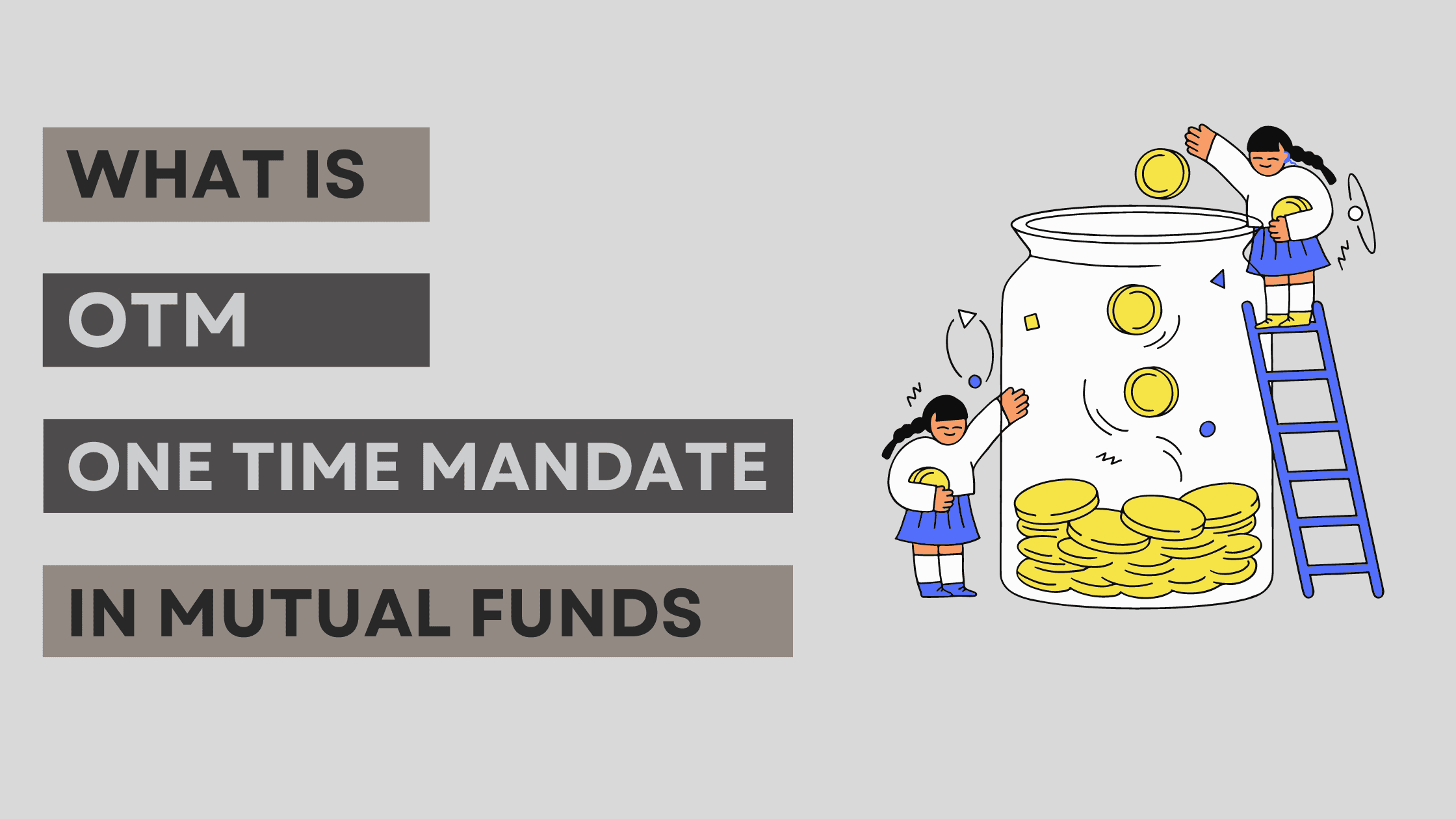OTM (One Time Mandate) is a new facility that is provided by mutual fund companies that allows investors to set up a single authorization for future transactions, such as investments or redemptions, without needing to repeatedly provide instructions.
How does OTM (One Time Mandate) Work?
Understanding One Time Mandate (OTM) works can help you streamline your investment processes and manage your mutual fund transactions more efficiently. Here’s a step-by-step guide to how OTM functions:
1. Authorization Setup
Initial Request: To initiate an OTM, you need to provide a one-time authorization to your mutual fund provider. It typically involves filling out an application form or submitting an online request.
Details Required: You will need to specify the details of the transactions you want to automate. This might include the amount, frequency (e.g., monthly, quarterly), and the specific mutual fund schemes.
2. Form Submission
Complete Documentation: Submit the completed OTM form along with any required documentation. This might include proof of identity, bank details, and your mutual fund account information.
Bank Mandate: Sometimes OTM requires a bank mandate where you authorize your bank to debit your account for the specified transactions. This ensures that funds are automatically transferred from your account to the mutual fund house as per the agreed schedule.
3. Activation Process:
Verification: Once you have submitted the authorization, the mutual fund company will verify the details and ensure that everything is in order.
Activation: After verification, the OTM is activated. This means that the mutual fund company now has permission to process transactions according to the terms you have set.
4. Automated Transactions
Transaction Execution: After OTM setup, the mutual fund company will automatically execute transactions on your behalf. This could include systematic investments or withdrawals (e.g., monthly withdrawals from a fund).
Frequency and Timing: Transactions will occur at the intervals you specified (e.g., the 5th of every month) without any need for further action from you. The mutual fund house will handle all the details.
5. Monitoring and Management
Regular Review: Even though OTM automates transactions, it’s a good idea to review your OTM settings. Ensure that your investments are aligned with your financial goals and make adjustments if necessary.
Updates and Changes: If you need to change the amount, frequency, or fund scheme associated with your OTM, you’ll need to update the mandate by submitting a revised request or form.
Cancellation: If you wish to stop the automated transactions, you can cancel the OTM by informing your mutual fund provider and bank. Make sure to follow the proper procedure to ensure that no further transactions are processed.
Why OTM (One Time Mandate) is Mostly Preferred?
|
Feature |
One Time Mandate (OTM) |
Systematic Investment Plans (SIPs) |
Systematic Withdrawal Plans (SWPs) |
Manual Transactions |
| Authorization | Single authorization for future transactions. | Requires separate setup for each SIP. | Requires separate setup for each SWP. | Requires individual instructions for each transaction. |
| Setup Effort | Minimal – one-time setup. | Ongoing setup and management are needed. | Ongoing setup and management are needed. | High – requires manual initiation each time. |
| Transaction Frequency | Customizable frequency (monthly, quarterly, etc.). | Typically set up for monthly investments. | Typically set up for regular withdrawals. | Each transaction must be manually initiated. |
| Flexibility | Can be used for SIPs, SWPs, and STPs. | Limited to investment contributions. | Limited to withdrawals only. | Varies; less flexible compared to OTM. |
| Cost Efficiency | Potentially lower transaction fees. | May have higher transaction costs compared to OTM. | Similar cost considerations as SIPs. | Can incur additional fees and transaction costs. |
| Error Reduction | Reduces the risk of errors due to automation. | Errors can occur if payments are missed or incorrect. | Errors can occur if withdrawals are missed or incorrect. | High risk of errors such as missed transactions. |
| Consistency | Ensures regular and consistent transactions. | Ensures regular investments. | Ensures regular withdrawals. | Requires active management to maintain consistency. |
| Convenience | High – once set up, requires no further action. | Moderate – requires periodic monitoring. | Moderate – requires periodic monitoring. | Low – requires constant attention and action. |
| Financial Planning | Simplifies budgeting and aligns with financial goals. | Focuses on disciplined investing but is less comprehensive. | Focuses on regular income but is less comprehensive. | Less predictable and harder to plan. |
Explore the Advantages and Disadvantages of OTM (One Time Mandate)
Advantages of OTM (One Time Mandate):
- OTM requires only a one-time setup, automating future transactions and reducing manual effort.
- Ensures regular and disciplined transactions, which helps in maintaining a steady financial strategy.
- It can be used for different types of transactions and allows customization in amounts and frequencies.
- It may offer reduced transaction fees and reduce the risk of errors associated with manual transactions.
- It provides predictable cash flows, making budgeting and alignment with long-term financial goals easier.
Disadvantages of OTM (One Time Mandate):
- Once set up, changing or adjusting transactions requires formal processes, which can be less flexible.
- Automated transactions might lead to overdraft if your account lacks sufficient funds.
- Errors in setup or changes in your financial situation can lead to incorrect transactions.
- There might be fees associated with setting up or managing OTM transactions, which could affect overall cost savings.
- Automation may reduce active monitoring and engagement with your investments.
Current Eligibility Criteria For OTM (One Time Mandate):
The eligibility criteria for setting up an OTM (One Time Mandate) for mutual funds can vary slightly depending on the mutual fund provider and country. However, here are the general requirements you would typically need to meet:
1. Active Mutual Fund Account: You must have an active mutual fund account with the fund house where you wish to set up the OTM.
2. Active Bank Account: You should have an active bank account linked to your mutual fund account. This is where the funds will be debited for investments or credited for redemptions.
3. KYC Compliance: You must be KYC-compliant. This involves submitting identity and address proof, and any other documents required by the fund house or regulatory authority.
4. Formal Authorization: You need to provide formal authorization to your bank and mutual fund company. This often involves filling out and submitting a specific OTM form or mandate.
5. Minimum Criteria: Some mutual funds may have minimum investment criteria for transactions carried out through OTM. Ensure your OTM instructions comply with these minimum amounts.
6. Adherence to Fund Policies: Different fund houses might have specific policies or requirements for setting up OTM. It’s essential to check these policies to ensure eligibility.
7. Bank Mandate: You need to authorize your bank to debit your account for the transactions. This usually requires filling out a bank mandate form and submitting it along with your OTM request.
8. Transaction Type: Ensure that the type of transactions you want to automate (e.g., Systematic Investment Plans (SIPs), Systematic Withdrawal Plans (SWPs), Systematic Transfer Plans (STPs)) is supported by the OTM facility of your mutual fund provider.
Steps to Verify Eligibility For OTM (One-Time Mandate)
- Contact Mutual Fund Provider: Reach out to your mutual fund provider to understand their specific requirements and verify your eligibility for setting up an OTM.
- Check Bank Requirements: Ensure your bank account meets the requirements for setting up an OTM, including any necessary mandates or authorizations.
- Review KYC Status: Confirm that your KYC process is complete and up to date with both your bank and mutual fund provider.
- Understand Fund Policies: Review the policies of the mutual fund house to ensure you meet any specific criteria they may have for OTM transactions.
- Complete Documentation: Fill out and submit all required forms and documentation to both your mutual fund provider and bank.
Summary For One Time Mandate (OTM)
Overall, OTM is a powerful tool for automating and managing mutual fund transactions with minimal ongoing effort. It is ideal for investors looking to streamline their investment process, ensure consistency, and enhance financial planning.
However, it’s important to weigh its advantages against potential drawbacks and verify eligibility and requirements with your mutual fund provider. If you want to invest money in Mutual Funds, then you should also check out Mutual Friend Success Stories in India.


